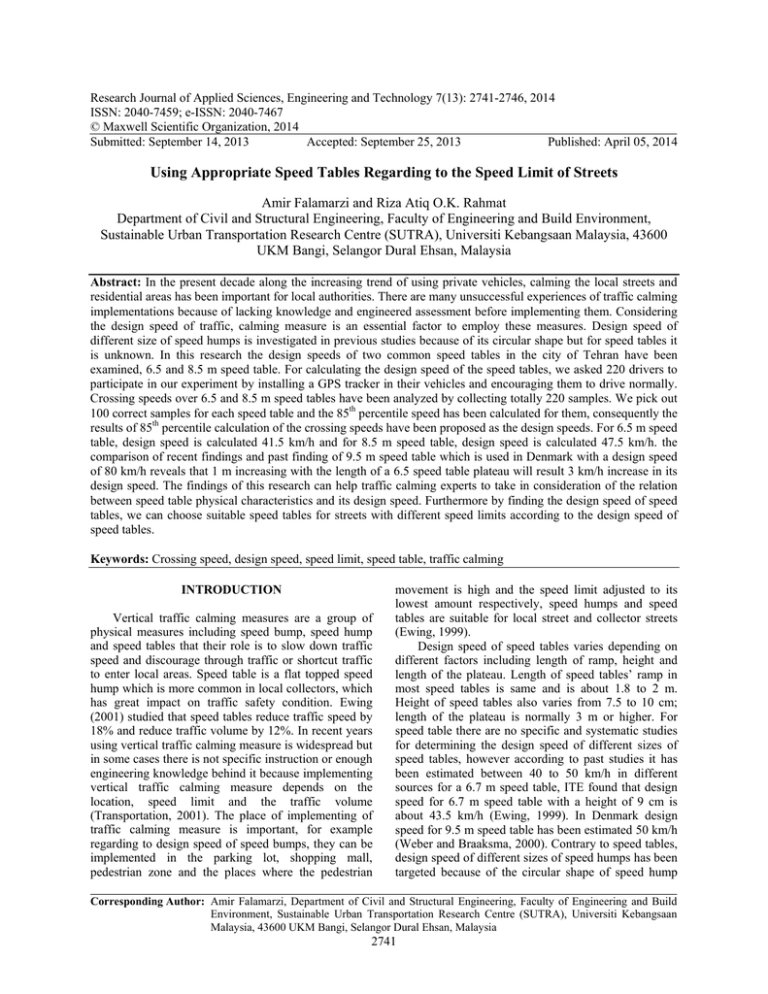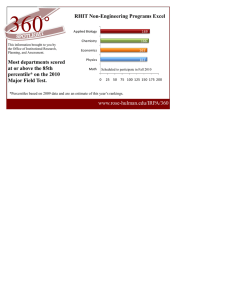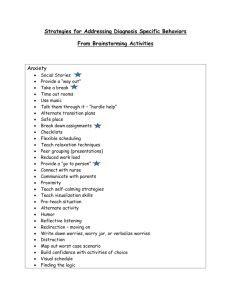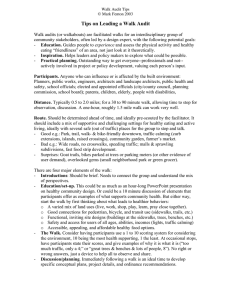
Research Journal of Applied Sciences, Engineering and Technology 7(13): 2741-2746, 2014
ISSN: 2040-7459; e-ISSN: 2040-7467
© Maxwell Scientific Organization, 2014
Submitted: September 14, 2013
Accepted: September 25, 2013
Published: April 05, 2014
Using Appropriate Speed Tables Regarding to the Speed Limit of Streets
Amir Falamarzi and Riza Atiq O.K. Rahmat
Department of Civil and Structural Engineering, Faculty of Engineering and Build Environment,
Sustainable Urban Transportation Research Centre (SUTRA), Universiti Kebangsaan Malaysia, 43600
UKM Bangi, Selangor Dural Ehsan, Malaysia
Abstract: In the present decade along the increasing trend of using private vehicles, calming the local streets and
residential areas has been important for local authorities. There are many unsuccessful experiences of traffic calming
implementations because of lacking knowledge and engineered assessment before implementing them. Considering
the design speed of traffic, calming measure is an essential factor to employ these measures. Design speed of
different size of speed humps is investigated in previous studies because of its circular shape but for speed tables it
is unknown. In this research the design speeds of two common speed tables in the city of Tehran have been
examined, 6.5 and 8.5 m speed table. For calculating the design speed of the speed tables, we asked 220 drivers to
participate in our experiment by installing a GPS tracker in their vehicles and encouraging them to drive normally.
Crossing speeds over 6.5 and 8.5 m speed tables have been analyzed by collecting totally 220 samples. We pick out
100 correct samples for each speed table and the 85th percentile speed has been calculated for them, consequently the
results of 85th percentile calculation of the crossing speeds have been proposed as the design speeds. For 6.5 m speed
table, design speed is calculated 41.5 km/h and for 8.5 m speed table, design speed is calculated 47.5 km/h. the
comparison of recent findings and past finding of 9.5 m speed table which is used in Denmark with a design speed
of 80 km/h reveals that 1 m increasing with the length of a 6.5 speed table plateau will result 3 km/h increase in its
design speed. The findings of this research can help traffic calming experts to take in consideration of the relation
between speed table physical characteristics and its design speed. Furthermore by finding the design speed of speed
tables, we can choose suitable speed tables for streets with different speed limits according to the design speed of
speed tables.
Keywords: Crossing speed, design speed, speed limit, speed table, traffic calming
INTRODUCTION
Vertical traffic calming measures are a group of
physical measures including speed bump, speed hump
and speed tables that their role is to slow down traffic
speed and discourage through traffic or shortcut traffic
to enter local areas. Speed table is a flat topped speed
hump which is more common in local collectors, which
has great impact on traffic safety condition. Ewing
(2001) studied that speed tables reduce traffic speed by
18% and reduce traffic volume by 12%. In recent years
using vertical traffic calming measure is widespread but
in some cases there is not specific instruction or enough
engineering knowledge behind it because implementing
vertical traffic calming measure depends on the
location, speed limit and the traffic volume
(Transportation, 2001). The place of implementing of
traffic calming measure is important, for example
regarding to design speed of speed bumps, they can be
implemented in the parking lot, shopping mall,
pedestrian zone and the places where the pedestrian
movement is high and the speed limit adjusted to its
lowest amount respectively, speed humps and speed
tables are suitable for local street and collector streets
(Ewing, 1999).
Design speed of speed tables varies depending on
different factors including length of ramp, height and
length of the plateau. Length of speed tables’ ramp in
most speed tables is same and is about 1.8 to 2 m.
Height of speed tables also varies from 7.5 to 10 cm;
length of the plateau is normally 3 m or higher. For
speed table there are no specific and systematic studies
for determining the design speed of different sizes of
speed tables, however according to past studies it has
been estimated between 40 to 50 km/h in different
sources for a 6.7 m speed table, ITE found that design
speed for 6.7 m speed table with a height of 9 cm is
about 43.5 km/h (Ewing, 1999). In Denmark design
speed for 9.5 m speed table has been estimated 50 km/h
(Weber and Braaksma, 2000). Contrary to speed tables,
design speed of different sizes of speed humps has been
targeted because of the circular shape of speed hump
Corresponding Author: Amir Falamarzi, Department of Civil and Structural Engineering, Faculty of Engineering and Build
Environment, Sustainable Urban Transportation Research Centre (SUTRA), Universiti Kebangsaan
Malaysia, 43600 UKM Bangi, Selangor Dural Ehsan, Malaysia
2741
Res. J. App. Sci. Eng. Technol., 7(13): 2741-2746, 2014
which make it easier for experts to estimate the design
speed. ITE found that there is a direct relation between
the design speed and the radius of speed humps (Ewing,
1999).
Having the design speed of vertical traffic calming
measure, help traffic experts to choose the functional
measures according to the road speed limit. If we can
find the relation between physical characteristics of
speed tables and their design speed, so we can assign
the suitable speed table for roads with specific speed
limit. In this research we want to expand our knowledge
about the design speed of speed tables by examining
our experiments on the implemented speed tables in the
city of Tehran. Because of carrying out the field
experiments and the fact that the length of speed table
ramp in most speed tables is about 1.8 m in Tehran and
also the height of speed tables is fixed (about 10 cm)
therefore the only variable to examine and analysis is
the length of the speed table plateau. In the city of
Tehran there are different implementations of speed
tables with different sizes of the plateau. In our research
we examined the design speed of the speed tables with
regard to the length of the speed table plateau.
MATERIALS AND METHODS
Using a traffic calming measure without
considering their design speed of and a speed limit of
the roads make traffic calming schemes unsuccessful. If
the design speed of traffic calming measure is lower
than the speed limit, it causes vehicles to stop in slow
points and sudden braking which will make residential
unsatisfied and also raise air pollution adjacent to traffic
calming measures. Vice versa if the design speed of
traffic calming measures is greater than the speed limit,
traffic calming measures will be ineffective because in
this case traffic calming measures cannot force drivers
to slow down. It must be a proper correlation between
design speed of traffic calming measures and a speed
limit of the roads. According to experiences, traffic
calming manual and expert recommendations, for
warning drivers toward their speed and also enforcing
them to adjust their speed to speed limit, design speed
of traffic calming measure must be set between 5 to 8
km/h lower than the speed limit also it is recommended
that for setting speed at 40 km/h the proper distance
between measures is 100 m and for speed limit equals
50 km/h, distance between measure should not exceed
more than 150 m (Engineers, 2001).
For measuring the crossing speed of vehicles in
transportation engineering studies, there are different
methods. LIDAR gun, Radar gun, stopwatch method
and GPS tracking are common methods for collecting
speed data of moving vehicles. Stopwatch method is a
conventional and inexpensive way for collecting speed.
In this method of marking two points as a start point
and end point and considering a length between these
Fig. 1: The LIDAR speed gun (the stalker LIDAR LR)
two points as a constant length, the time while a vehicle
passes from the start point and reaches to end point will
be stored by an observer and then the speed will be
calculated through dividing the length by the stored
time. Stopwatch method is simple and easy but
regarding to the short length of speed tables this method
is not accurate for determining the crossing speed of
speed tables.
Radar gun is a commonly used method to collect
speed of moving vehicles. This could be portable or
installed at a specific location (Currin, 2011). The radar
speed gun is a type of Doppler radar where by sending
a signal toward a moving vehicle and then detecting the
frequency changes coming from the reflection, can
determine the speed of objects. Reflected waves are
different while an object moving toward or away from
the gun so the observer can detect the direction of
vehicles. It must be taken into account that the
performance of the speed guns is acceptable if there is
no angle between moving objects and observer. LIDAR
gun is more complicated and recently used by police
forces for enforcing the speed limit on highways. The
LIDAR gun function is similar to radar speed gun but
the difference is using the laser technology and makes it
more reliable than a radar speed gun (Daniel et al.,
2012). Applying radar speed gun and the LIDAR gun in
city of Tehran for our research were needed to be
approved by police and authorities. Hence using these
devices for our research were not accessible. Figure 1
illustrates the LIDAR speed gun.
In our research a GPS tracker is used. The GPS
tracker is an electronic device which can store data
related to speed and movement of vehicles. By having
the distance and speed, we can derive a speed profile
for moving vehicles. Figure 2 illustrates a diagram of
speed profile providing by a GPS tracker before and
after passing traffic calming measures in the city of the
Genovese (García et al., 2011).
In order to examine the crossing speed at a speed
table at first we decided to select streets which speed
tables are implemented on. According to traffic calming
manual it is recommended to install speed table on
collector streets or local streets and it must be avoided
to install them on arterial streets or street with high
traffic volume. A collector street is the street which its
function is to collect traffic volume from local streets
and transfer them to arterial streets or main streets
(AASHTO, 2004). Usually trip generator developments
2742
Res. J. App. Sci. Eng. Technol., 7(13): 2741-2746, 2014
Fig. 2: Speed profile before and after passing traffic calming measures in Genovese (García et al., 2011)
which serve residential areas and local streets are
located in collectors such as local schools, parks and
small shops.
In this study for investigating the design speed of
speed tables, two sizes of speed table have been
selected. The length sizes of selected speed table are 6.5
and 8.5 m and these two speed tables have been
implemented at midpoint of streets. These speed tables
have 1.8 m ramp and the height of them is almost 10
cm (the length of plateau for the 6.5 m speed table is
about 3 m and for the 8.5 m speed table is about 5 m
after subtracting the length of speed table ramp from
the total length) and both of them are installed in
collector streets in the north of Tehran. We found other
sizes of speed table, but the problem was the location
and design of them, implementation at the beginning of
streets is not acceptable because the vehicle is not still
accelerated, also, implementation at the end of the
streets cannot be acceptable because of slowing down
of speed. Furthermore, the length of speed table ramp in
some implemented speed tables was below 1.5 m and in
some cases the height of speed tables was higher than
10 cm so they have been rejected for our study.
To examine the crossing speed of speed tables, for
each speed tables we stopped drivers randomly and
asked them to cooperate with us. We installed the GPS
tracker in their car and recommend them to drive
normally. García et al. (2011) experimented same
successful method, in that study, the GPS tracker had
been employed to store the speed profile of vehicles
before and after the traffic calming measures.
In our research, for each speed table, we repeated
the experiment by 100 drivers. To ensure that drivers
have the enough time to accelerate and speed up from
the starting point we installed a GPS tracker in vehicles
200 m prior to speed tables and replaced it 200 m after
speed tables for letting the driver to decelerate and slow
down gradually without minimum effect on their speed
when crossing over the speed tables. The traffic
condition when the experiment is carried out must be in
free flow traffic otherwise the function and the impact
of speed table cannot be monitored accurately. Totally
220 times the experiment has been carried out and
about 10% of them were excluded because of non-free
flow traffic, stopping before speed tables and an
unusual behavior of drivers when driving their car at
the speed tables.
In order to determine the design speed of speed
tables, we have to consider 85th percentile speed as a
reliable method to measure speed. (85th percentile)
speed is the speed in which 85th percentile of moving
vehicles at or below that Roess et al. (2004). (85th
percentile) speed is not the peak of speed but it is
assumed that 85 percentile of drivers, drive at a safe
speed. Transportation (2000) stated that 85th percentile
speed is important because the majority of drivers are
cautious and responsible and avoid road accidents also
reaching their destinations in minimum delay and
shortest distance is their desire. To calculate the 85th
percentile speed, firstly speed distributing frequency
must be calculated from our data, the speed distributing
frequency determines a number of vehicles driving at a
2743
Res. J. App. Sci. Eng. Technol., 7(13): 2741-2746, 2014
certain speed, for example, driving at a speed of 35
km/h. Cumulative frequency is the summation of speed
distributing frequency adding to each other from lower
speed to higher speed (first row to last row).
Cumulative percentages represent the percentage of
cumulative frequency.
In most cases the 85th percentile speed cannot be
achieved without sorting the data. In this regard we
have employed the Eq. (1) to achieve the 85th percentile
speed as follows:
𝑆𝑆85 =
85−𝑃𝑃𝑚𝑚𝑚𝑚𝑚𝑚
𝑃𝑃𝑚𝑚𝑚𝑚𝑚𝑚 −𝑃𝑃𝑚𝑚𝑚𝑚𝑚𝑚
(𝑆𝑆𝑚𝑚𝑚𝑚𝑚𝑚 − 𝑆𝑆𝑚𝑚𝑚𝑚𝑚𝑚 ) + 𝑆𝑆𝑚𝑚𝑚𝑚𝑚𝑚
(1)
where,
𝑆𝑆85 = Represents the 85th percentile speed which is
our target
𝑃𝑃𝑚𝑚𝑚𝑚𝑚𝑚 = Represents the higher amount of cumulative
percent, e.g., 86th %
𝑃𝑃𝑚𝑚𝑚𝑚𝑚𝑚 = Represents the lower amount of cumulative
percent, e.g., 79th%
𝑆𝑆𝑚𝑚𝑚𝑚𝑚𝑚 = Represents the speed of 𝑃𝑃𝑚𝑚𝑚𝑚𝑚𝑚
𝑆𝑆𝑚𝑚𝑚𝑚𝑚𝑚 = Represents the speed of 𝑃𝑃𝑚𝑚𝑚𝑚𝑚𝑚
RESULTS
After collecting the crossing speeds for the speed
tables from the GPS tracker, 85th percentile speed for
each speed table is calculated through Eq. (1). By
substituting the collected data into Eq. (1), 85th
percentile speed for the 6.5 m speed table calculated:
41.5 km/h. Table 1 illustrates the frequency distribution
of the crossing speeds for the 6.5 m speed table also
Fig. 3 illustrates a cumulative speed distribution plot for
the 6.5 m speed table:
𝑆𝑆85 =
85−80
𝑆𝑆85 =
85−78
90−80
(42 − 41) 41 = 41.5
(2)
(48 − 47) + 47 = 47.5
(3)
Table 1: Frequency distribution of the crossing speed for the 6.5 m
speed table
Speed
Cumulative Cumulative
Percentile
(km/h)
Frequency
frequency
(%)
speed
35
5
5
5
36
10
15
15
37
8
23
23
38
14
37
37
39
16
53
53
40
12
65
65
41
15
80
80
85th speed
42
10
90
90
43
5
95
95
44
2
97
97
45
3
100
100
Table 2: Frequency distribution of the crossing speed for the 8.5 m
speed table
Speed
Cumulative Cumulative
Percentile
(km/h)
Frequency
frequency
(%)
speed
40
4
4
4
41
7
11
11
42
9
20
20
43
9
29
29
44
10
39
39
45
10
49
49
46
14
63
63
47
15
78
78
85th speed
48
14
92
92
49
5
97
97
50
1
98
98
51
2
100
100
Table 3: Summarization of the design speed for the tested speed
tables
Speed table length (m)
85th percentile design speed (km/h)
6.5 m speed table
41.5
8.5 m speed table
47.5
9.5 m speed table
50.0
Respectively, in the 8.5 m speed table, the 85th
percentile speed is obtained 47.5 km/h regarding with
100 speed samples. Table 2 illustrates the frequency
distribution of the crossing speeds for the 8.5 m speed
table. Cumulative speed distribution plot for the 8.5 m
speed table has been illustrated in Fig. 4:
92−78
According to the findings and the 85th percentile
speed calculations, design speed of the 6.5 and 8.5 m
speed is 41.5 and 47.5 km/h. In this regard 85th
percentile speed has been increased associated with the
speed table length. By Increasing 2 m in the length of
the 6.5 m speed table, design speed increased around 6
km/h from 41.5 to 47.5 km/h at a 8.5 m speed table.
Two meter increase in speed table length will result 6
km/h increase in design speed of speed tables it proves
the theory that longer speed table have higher design
speed. Table 3 summarized the results of the current
study of design speed for 6.5 and 8.5 m speed
Fig. 3: Cumulative frequency distribution for the 6.5 m speed
table
tables and the previous study in the 9.5 m speed table in
Denmark.
Analyzing the data collected from the GPS which
is represented by the speed-distance profile show that
most of vehicles decelerate and slow down their speed
about 50 to 25 m prior to speed tables and crossing
2744
Res. J. App. Sci. Eng. Technol., 7(13): 2741-2746, 2014
Fig. 4: Cumulative frequency distribution for the 8.5 m speed
table
speed reaches to its lowest speed at the top of speed
tables. After passing speed table vehicles accelerate and
speed up. While conducting our experiments we found
that, behavior of drivers encountering speed tables is
not same and it changes in drivers’ age, sex and vehicle
type. We found out that due to a lower level of risk in
elder drivers and women drivers, they tend to slow
down their speed around 40 to 50 m before speed tables
and usually drive cautiously in this regard, on the other
hand, younger drivers and male drivers put lower
distance about 20 to 30 m before heading speed tables
to slow down. Furthermore drivers of four wheel cars
pass speed tables with higher crossing speed than a
normal sedan car due to their confidence in their
vehicle safety.
During the field experiment randomly we asked
some drivers to express their ideas about their
satisfaction and comfort when passing speed tables,
most of them answered that they are more satisfied with
speed tables than speed humps due to higher crossing
speed and passing them without needing to slow down
or stop their vehicles close to speed tables. On the one
of collector streets, during collecting the speed data of
the 6.5 m speed table, local drivers expressed that
before implementation of the current speed table, there
was a speed hump instead of speed table and that
measure caused dozen of drivers to break suddenly and
regarding to the large number of vehicles passing the
street daily, traffic accident was unavoidable. Also local
drivers and neighborhoods commented that, the design
of speed tables is more effective than speed hump in
term of speed adjustment, because in addition of
forcing drivers to decrease their speed it can give
drivers the flexibility and time to adapt their speed with
the design speed of speed table due to the long surface
of speed tables.
DISCUSSION AND CONCLUSION
The main contribution of this research is to develop
our findings about the relation between physical
characteristics of vertical traffic calming measures
especially speed tables and design speed of them and
help traffic calming experts to select measure according
to the road speed limit. The assessment of our
experimental results in Tehran represents that
increasing the length of speed table for only 1 m will
averagely increase the design speed of speed tables
about three km/h. It means that if we add 2 m to the
length of 6.5 m speed table with a height of 10 cm,
design speed will change from 41.5 to 47.5 km/h. It can
be predicted that decreasing length of speed table can
reduce the design speed of speed tables inversely.
There is no conflict between the present study and
the finding of ITE for the 6.7 speed table, because the
difference between the design speed in the present
research and the past research is due to the height of the
speed tables. In earlier research, the 6.7 m speed table
with 9 cm height has been investigated and the design
speed of 43.5 km/h has been recorded whereas in
present study 6.5 m speed table with a height of 10 cm
has been investigated and the design speed of 41.5 km/h
has been recorded. It can be referred to this fact that the
higher height enforces drivers to slow down their speed
to pass speed tables more safely and avoid shocks
(Weber and Braaksma, 2000).
The recommendation for the differential between
design speed of speed table and road speed limit is 5 to
8 km/h therefore for collector street with 45 km/h and
considering the differential speed, the proper design
speed of speed table is 37 to 40 km/h hence 6.0 m speed
table with approximate design speed of 40 km/h may be
suitable respectively, for collector street with speed
limit of 50 km/h the proper design speed of speed table
is 42 to 45 km/h hence 7.5 m standard speed table with
approximate design speed of 44.5 km/h is suitable. For
a collector street which is allocated for bus route or
street with a speed limit of 55 km/h or higher, the 9.5 m
speed table with a design speed of 50 km/h is
recommended. For collector streets with speed limits of
40 km/h or lower, the standard speed table cannot be
implemented due to minimum 2 m length for the length
of the speed table plateau, in this regard, using speed
hump with the total length of 4.2 m is appropriate.
It must be mentioned that in this research only
changing the length of the speed table plateau has been
examined. The height of speed table is also a critical
issue which can affect the function of speed tables, it is
recommended for future studies to examine the effect of
changing the length and height of speed tables
simultaneously and with more sample cases in order to
propose a mathematic model (linear or nonlinear)
including the height and the length of speed tables as
the independent variables and the design speed as the
dependent variable. Traffic simulating software such as
AIMSUN NG and VISSIM can help researchers to
generate the samples for future studies if the number of
samples in physical experiment is limited. Furthermore
it must take into consideration that maximum height of
2745
Res. J. App. Sci. Eng. Technol., 7(13): 2741-2746, 2014
speed table recommended in the different manual and
standard is about 10 cm hence more than this height
may disrupt the natural function of speed tables
(Engineers, 2001).
REFERENCES
AASHTO, 2004. A Policy on Geometric Design of
Highways and Streets. American Association of
State Highway and Transportation Officials,
Washingtn, DC.
Currin, T.R., 2011. Introduction to Traffic Engineering:
A Manual for Data Collection and Analysis.
Nelson
Engineering,
Cengage
Learning,
Independence, KY.
Daniel, B.D., A. Nicholson and G. Koorey, 2012. The
effects of vertical speed control devices on vehicle
speed and noise emission. Proceeding of the ARRB
Conference. Perth, Western Australia, Australia.
Engineers, D., 2001. Traffic Calming Protocol Manual.
Municipality of Anchorage, Anchorage, Alaska.
Ewing, R.H., 1999. Traffic Calming: State of the
Practice. Institute of Transportation Engineers,
Washington, D.C.
Ewing, R., 2001. Impacts of traffic calming.Transport.
Quart., 55(1): 33-46.
García, A., A.J. Torres, M.A. Romero and
A.T. Moreno, 2011. Traffic microsimulation study
to evaluate the effect of type and spacing of traffic
calming devices on capacity. Proc. Soc. Behav.
Sci., 16: 270-281.
Roess, R.P., E.S. Prassas and W.R. McShane, 2004.
Traffic Engineering. 3rd Edn., Pearson/Prentice
Hall, Upper Saddle River, NJ.
Transportation, T.D.O., 2000. Procedures for
Establishing Speed Zones. State or Province
Government Publication, Austin, Texas.
Transportation, P.D.O., 2001. Pennsylvania`s Traffic
Calming Handbook. Pennsylvania Department of
Transportation, Pennsylvania.
Weber, P.A. and J.P. Braaksma, 2000. Towards a North
American geometric design standard for speed
humps. ITE J., 70(1): 30-39.
2746









